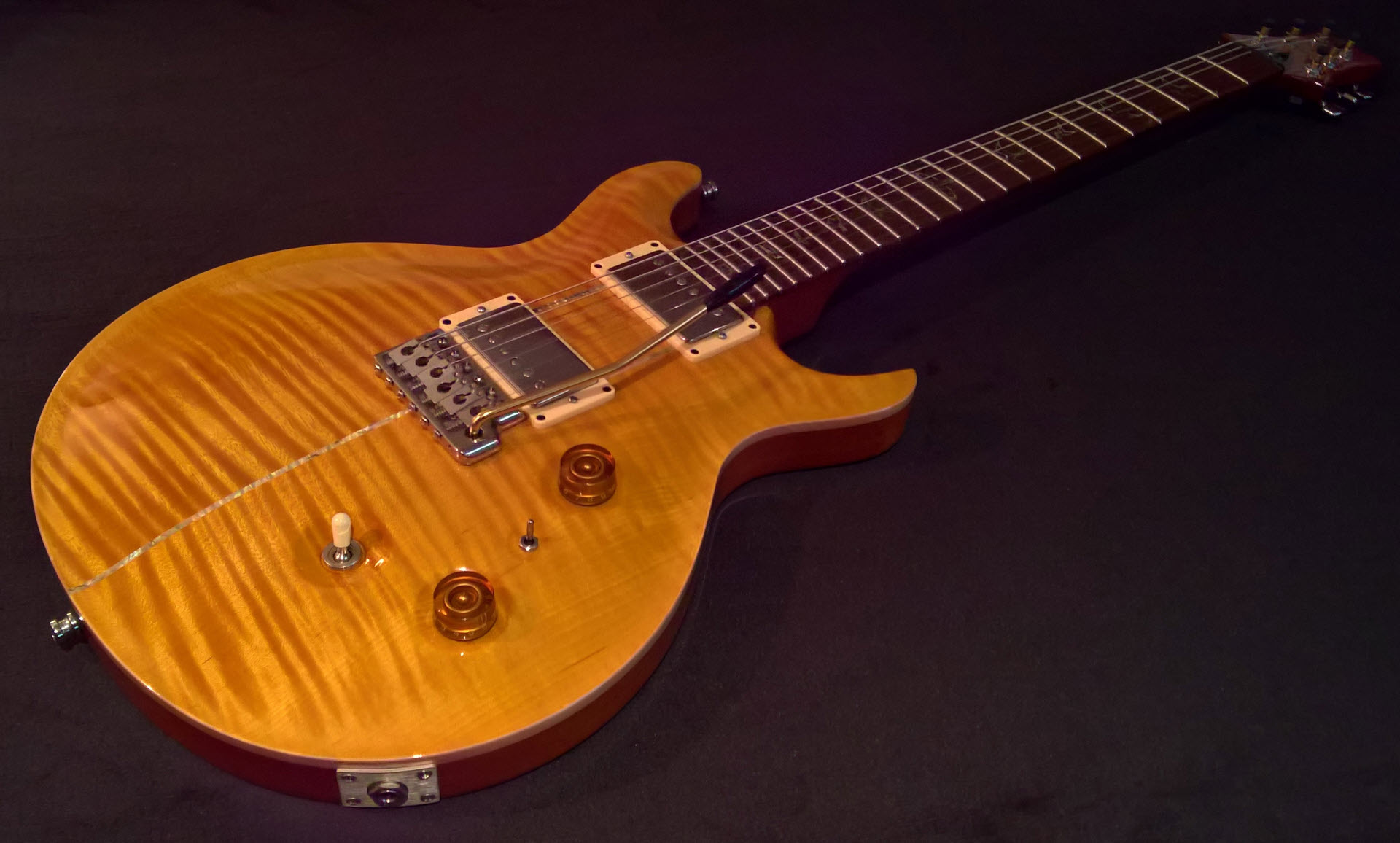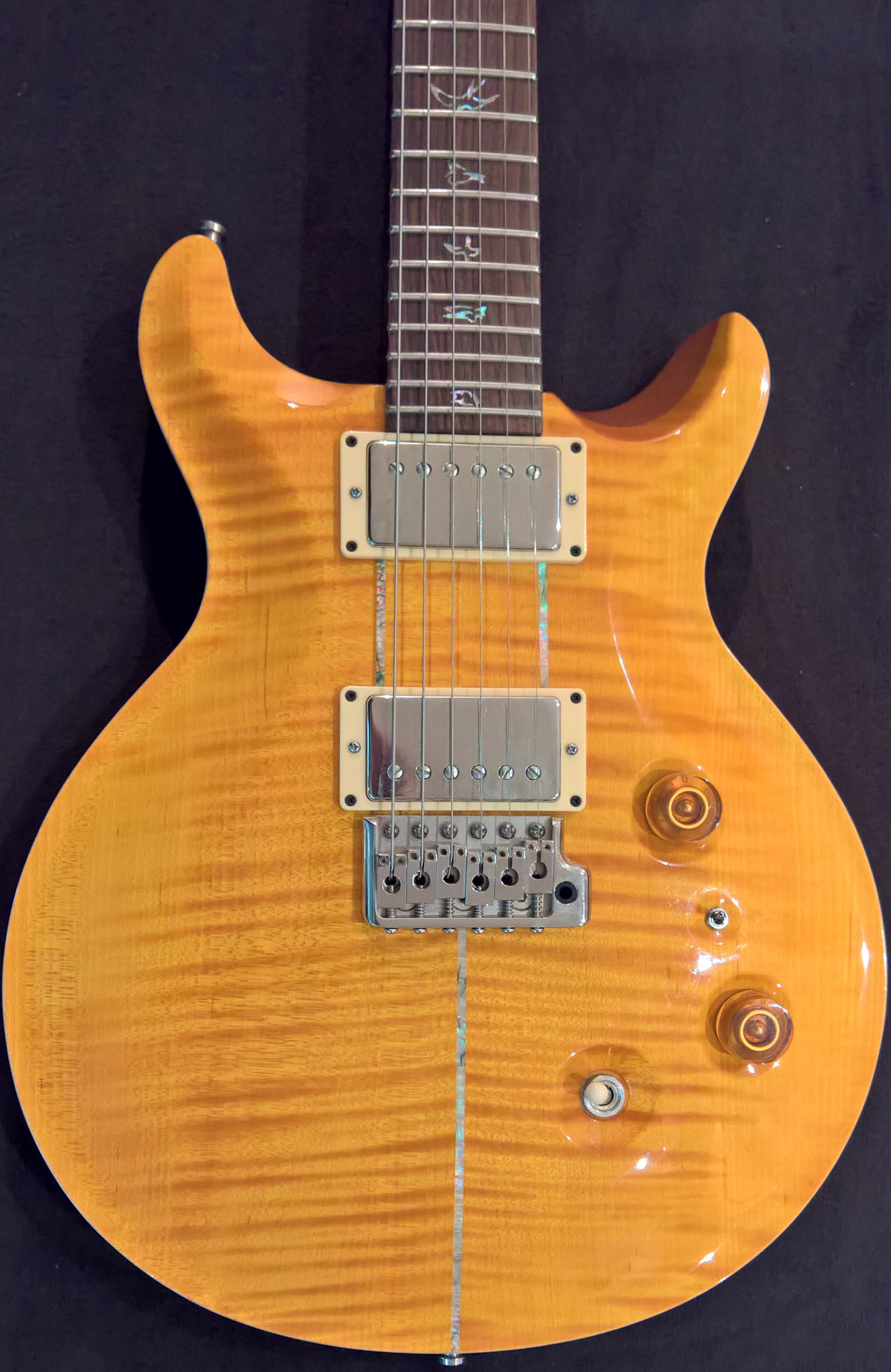PRS Santana MD

Specifications
- Carved flame maple top
- Mahogany back
- Inlaid abalone purfling
- Mahogany "Santana" wide-fat neck
- Rosewood fretboard
- 24.5" scale length
- 24 frets
- PRS Tremolo bridge
- Low-mass locking tuners
- Santana MD Treble and Bass humbucking pickups
- Volume and Tone controls, 3-way toggle
- Mastering Voice Control circuit
Paul Reed Smith discusses the Mastering Volume Control used in both the Santana MD (Multi-Dimensional) and the McCarty II. Paul Reed Smith Guitars McCarty II with Mike Ault
Increased options
The major difference is the Mastering Voice Control pot, powered by two nine-volt blocks (with a relatively short battery life of approximately 40 hours).
"Originally, Carlos Santana was looking for more tonal options from his guitar, more in the direction of Stevie Ray Vaughan," explains PRS's J Hayes. "So Paul came up with this active circuit that would give Carlos a '60s single-coil sound but without the hum issues that plague such instruments. The second version that is used in the McCarty II is based on the same concept."
The circuit is engaged by a mini-toggle switch — with the MVC switched out the guitar remains passive and will work even with dead batteries — and the tone control is replaced by a centre-notched pot which moves from the single-coil tones to "heavy metal sounds".
"It's completely variable," said Paul Reed Smith earlier this year, "like a pan pot on a console. And it was designed by a guy who does consoles. I couldn't be more pleased. Watching people's jaws drop has just been a hoot."
Mastering commander
Engaging the MVC does produce some noticeable background hiss. Turning it fully anti-clockwise produces that '60s single-coil sound and, as ever, with a little volume control reduction the sound is certainly accurate with reduced mids and a tighter low-end.To our ears it's most useful with the mixed and neck positions - the former almost Tele-like in its hollowness, the latter with a little gain boost that sits nicely in Texas-y territory. Turn the MVC the other way and you're primarily hearing an enhanced low-end with slightly scooped mids (Smith believes the high-end to be "more Tele-like" but that's harder to perceive).
It certainly works for bigger 'metal' voices, but it's a little like moving from a small combo to a half-stack, or like a double-cut to a single-cut. To put it another way it's more than just metal and produces a really huge rhythm sound with even just '70s-era amp tones. In short, this is a vastly expanded McCarty.
With the quality of construction and finishing a byword at PRS - to be honest it's getting better - it's no surprise that this guitar is pro-spec'd and ready to go.
PRS's McCarty II does what it says on the tin. Aside from its solid passive performance - a real workhorse guitar for classic rock use - the new active circuit brings both a highly accurate single-coil tone (without the noticeable volume drop of the usual passive coil-splits) and a surprisingly useful 'metal' sound that can certainly be used for older rock rhythm styles too.But as good as it is, we can't help thinking the MVC should be in a pedal, maybe with a gain boost, which could be mains-powered. That way we wouldn't have to shell out a considerable amount of cash for the guitar (as well as two nine-volt blocks every 40 hours). There are many players who simply wouldn't use active guitars but happily step nightly on active stomp boxes!
Source: Music Radar
Guitar weighs 8 lbs. The substantial case weighs 17 1/2 lbs. without the guitar. This latter improved Santana model has the Om truss rod cover replaced with the Multi-Dimensional designation (MD) Paul Reed Smith and Santana came up with together. From PRS website:
"After nearly two decades of playing Paul Reed Smith guitars and three versions of his Santana Guitar models (Santana SE guitars aside), Carlos — along with Paul Reed Smith, of course! — has developed a Santana Signature model which combines some of the best features of all the previous models. Plus some cool new additions."Santana MD: Guitar of Many Tones
"The “MD” designation in the model stands for “Multi-Dimensional,” and is a reference to the fact that the Santana MD can achieve a variety of tones. This quality makes it an ideal instrument for guitarists who want to produce a number of different sounds from the same guitar. A large part of this “multidimensionality” resides in the electronic circuit. Besides the standard Santana Guitar Volume and Tone knobs, and 3-way pickup selector switch, it includes a mini-toggle that delivers a Strat-like ’60s tone — possibly by putting one or both of the pickups out of phase. The new function is called a “Mastering Voice Control.”Something Old, Something New . . .
" In keeping with the “best of all possible world's theme, the PRS Santana MD guitar includes classic features from previous Santana guitars, like the traditional “Santana wide fat” neck shape, Rosewood fretboard, and Mahogany body with carved flame Maple top and Abalone Purfling. However, there are changes as well. Most notably, the positions of the controls have been altered. While the 3-way pickup selector switch and Tone knob are still roughly between the tailpiece and the bridge, the Volume knob has been shifted to a position right next to the bridge pickup. This makes it easier to control the volume while playing, which Santana likes to do. The new mini-toggle is in between the two knobs.
Even the famed Abalone bird-shaped inlays on the fretboard have gotten a facelift: instead of being solid as on previous Santana guitar models, they’re outlined."Santana Guitar Journey
"This latest foray into Santana Signature models is allegedly the result of a two-year process of refinement carried on by Carlos Santana and Paul Reed Smith. Part of the inspiration was the Stratocaster that Santana used on a Smokey Robinson album — and fell in love with."


Paul Reed Smith Demo of McCarty II with MVC
Same MVC control circuitry as Santana MD